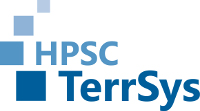Water flow and permeability distribution in a tectonically limited hard-rock aquifer
In this project, we study water flow and permeability distribution in a tectonically complex karst aquifer on a regional scale by means of high-performance computing. Karst aquifers are highly heterogeneous and hydraulic properties are highly uncertain.
The study area Hastenrather Graben, located about 15 km northwest of the city of Aachen, has a complex tectonic history. Folded Devonian to Carboniferous bedrocks outcrop on the graben’s shoulders and are overlain within the graben by unconsolidated Tertiary to Quaternary sediments. This causes the unconsolidated porous aquifers to interact with the main Carboniferous hard-rock aquifer.
This, and possible hydraulic connections between nappes will be addressed in the simulation. The main limestone aquifer is used by the local water utility enwor which kindly supplies preliminary hydraulic and geological data. Based on these data we set up a detailed, three-dimensional geological model of the study area by means of spatial interpolation and implicit geometric modeling. This method implies geological surfaces by volumetric functions which can be defined by a small amount of input points, instead of defining surfaces by digitizing their shape explicitly.
Further hydraulic and geophysical field tests will supplement this data base. Tracer tests can be performed in dipole mode using little mineralised water. Additional monitoring will be based on geoelectric methods. These data will help to update the conceptual model continually.
We employ high-performance computing for analysing experimental data, in particular piezometer time series and tracer tests. Field-scale, high-resolution simulations address fracture and fault flow and related permeability using an equivalent porous medium approach. Hydraulic parameters and their uncertainties are estimated by simulations based on Monte-Carlo and Ensemble-Kalman-Filter approaches.
Forward and inverse models of this size can be realized only with high-performance computing power. To this end, the existing OpenMP parallelized version of the finite difference code SHEMAT-Suite is used to perform the computationally expensive simulations in a first step. This parallel version is proven to scale linearly with up to 96 parallel processors. In a further step, a hybrid parallel version of SHEMAT-Suite is developed, which combines shared and distributed memory parallelization approaches (OpenMP and MPI). This hybrid version will allow to address over 1000 parallel processors in the supercomputing environments at the Jülich Supercomputing Center and at RWTH Aachen University for performing the ambitious numerical simulations.

